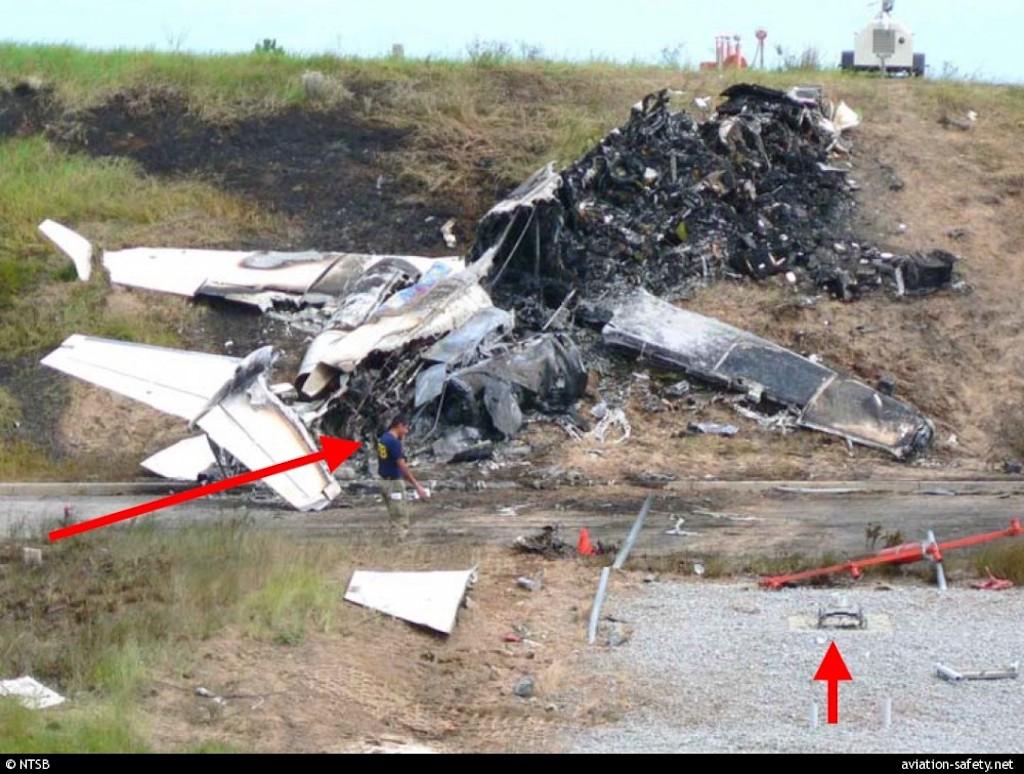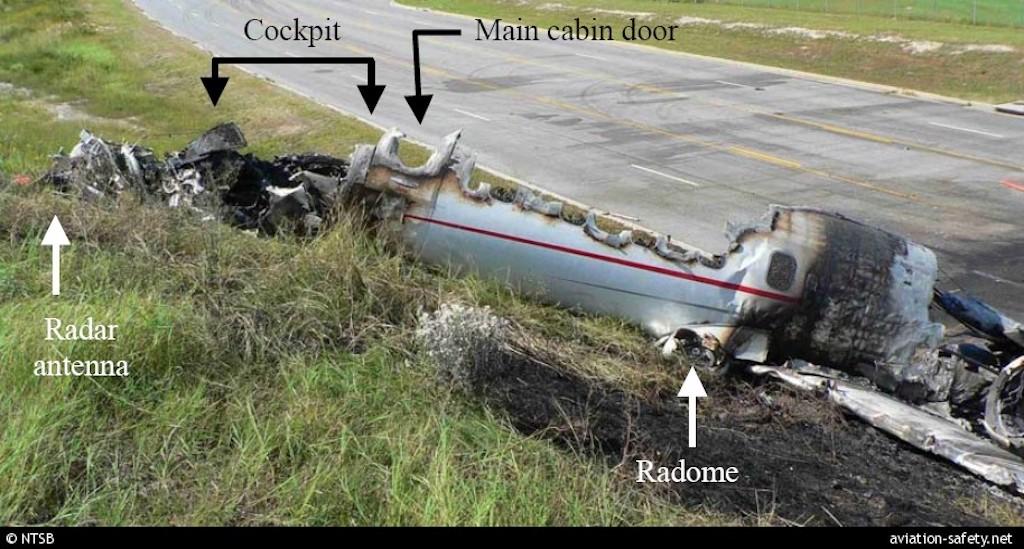
In Part 1, we discussed flight crew reactions to tire failures on takeoff.
Tire failures can cause serious secondary damage and could lead to fire.
Our examination of the business jet sample also revealed that tire failures caused secondary damage to other critical systems in nearly two-thirds of the tire failure events, all of which compounded aircraft damage and, in many instances, led to a further decrease in braking effectiveness and aircraft control problems. High-pressure hydraulic lines were often severed by the high-speed tire failure, resulting in a loss of wheel brakes. High-speed debris from the shredding tires often punctured flaps and wing surfaces. On some occasions, the shredded debris was ingested by aft-mounted engines, causing foreign object damage (FOD). In many cases, tire debris jammed squat switches or “air-ground mode sensors” and inhibited the deployment of spoilers and thrust reversers.
Potential For Fire
Hydraulic fluid leaking from ruptured hydraulic lines or fuel leaking from punctured fuel tanks has been ignited by hot brakes, resulting in post-incident fires. Both of these circumstances happened to the flight crew of a Hawker 700 on Sept. 8, 1994, following an aborted takeoff at Reno, Nevada. According to the NTSB report, the aircraft was near V1/Vr in the takeoff ground roll when the flight crew heard a loud bang followed by a vibration in the airframe. A second loud bang was then heard as the captain aborted the takeoff. A fire was observed on the right wheels and in the wheel well by air traffic controllers who promptly notified both the flight crew and aircraft rescue and firefighting (ARFF) services. The occupants evacuated the aircraft after it came to a stop on a taxiway while airport fire department units responded and extinguished the fire. Inspection of the aircraft revealed that both right main gear tires had blown out during the takeoff roll. The ground fire was found to have spread from the wheel well to the hell hole and into the left wing root area.
An FAA inspector from the Reno Flight Standards District Office examined the aircraft after the incident and noted that hydraulic and fuel lines routed through the right wheel well area were severed. The ventral fuselage fuel tank was also found to be punctured.
The NTSB determined the probable cause of this accident was the rupture of fuel and hydraulic lines and the fuselage fuel tank by tire pieces during the tire blow-out sequence. [U.S. NTSB Accident Report No. LAX94LA356.]
The potential for serious aircraft damage is significant with high-speed aborts, and even once the aircraft has been brought to a stop, all due consideration should be given to an emergency evacuation and ARFF response for the potential of hot brakes or post-incident fire.
How to Handle a Tire Failure

The signs of tire failure and the lack of timing for slow, deliberate decision making during the critical high-speed phase of takeoff complicate a flight crew’s ability to make the important go/no-go decision. Some of the flight crews heard a noise loud enough to be confused with an engine compressor stall; some just heard a loud noise; and others heard no sound at all. Some of the tire failures were not felt at all; some caused the airplane to pull to one side; and others caused the entire airplane to shake and vibrate.
V1 is based solely on engine failure. It is not designed to account for other failures and malfunctions. A reject decision with a blown tire must not be based on V1 since decision speed is based on engine failure, not the malfunction of other systems or blown tires. Blown tires negatively affect braking action, and an aircraft suffering from a tire failure will lack the traction needed to duplicate the published balanced field length.
According to the Pilot Guide to Takeoff Safety, if a tire failure is suspected at fairly low speeds, the takeoff should be rejected promptly. The crew should anticipate that additional tires may fail during the stop attempt and that directional control may be difficult. They should also be prepared for the possible loss of hydraulic systems, which may cause speed brake or thrust reverser problems. Since the stopping capability of the airplane may be significantly compromised, the crew should not relax from a maximum effort RTO until the airplane is stopped on the pavement.
As with any abort, especially in low visibility conditions, it’s vitally important for the flight crew to notify the tower as soon as possible so the tower can shut down the runway from further operations to prevent other aircraft from taking off or landing on it.
Flight crews should be on guard for a further loss of braking and/or steering, as well as hydraulic fluid or fuel from punctured fuel tanks leaking onto hot brakes. They should ascertain the degree of the damage and whether the aircraft occupants should egress, or whether the flight crew should shut down and request a ground tow. Anytime there is a suspected tire failure the flight crew should notify the tower so that the runway can be inspected for any possible debris that may have been left on it.
It is not a straightforward issue to define when a takeoff should be continued or rejected after a suspected tire failure. The NTSB’s accident report referenced numerous research reports that determined that it is generally better to continue the takeoff. It is fairly obvious, however, that an RTO initiated at high speed with a suspected tire failure is a very risky situation. The chances of an overrun are greatly increased simply due to the loss of braking force from one wheel. If additional tires should fail during the stop attempt, the available braking force is even further reduced.
If the flight crew opts to continue the takeoff, the subsequent landing may take advantage of a lower weight and speed. Also, the crew will be better prepared for possible vibration and/or control problems. Most important, however, is the fact that the entire runway will be available for the stop maneuver (as opposed to the limited amount of runway remaining if the crew attempted to reject the takeoff).
The Pilot Guide to Takeoff Safety suggests that leaving the gear down after a suspected tire failure will not jeopardize the aircraft as long as all engines are operating. However, if an engine problem should develop later in the takeoff sequence due to FOD ingestion, the airplane’s climb gradient and/or obstacle clearance capability may be significantly reduced if the landing gear is not retracted. Once at a safe maneuvering altitude, the flight crew then has the time to begin a deliberate decision-making process to bring the aircraft safely back to the ramp.
During the preparation for landing, the flight crew should consider the likelihood of loss of the braking system or nosewheel steering, and possible problems with thrust reverser deployment. Additionally, with the distinct possibility of damage to the flaps, it’s likely that they will have to remain in the takeoff position. Stopping distances, of course, will be considerable and will require very long runways. Needless to say, good pilot judgment would suggest picking the longest and widest available runway that is aligned with the wind.
Handling A High-Speed Tire Failure, Part 1, https://aviationweek.com/business-aviation/safety-ops-regulation/handli…






Comments